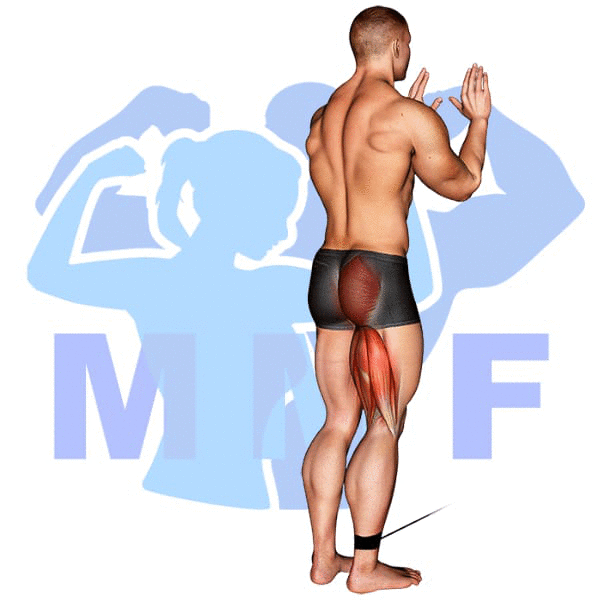Are you struggling to isolate and activate your glutes during your lower body workouts? One common culprit for this issue is a weak mind-muscle connection in the glutes. And that’s where the one-legged cable kickback comes in! This exercise is a fantastic way to target and strengthen the glute muscles while improving your mind-muscle connection. In this blog post, we’ll go over the proper form and technique for performing the one-legged cable kickback, as well as some variations to make the exercise more challenging as you progress. So grab a cable machine and let’s get started!
One Legged Cable Kickback Summary
- Primary Muscles: Gluteus Maximus
- Secondary Muscles: Adductor Magnus
- Equipment: Cable Machine with Ankle Strap
- Mechanics Type: Compound
- Force: Push
- Utility: Auxiliary

One Legged Cable Kickback Instructions
- Start off by setting up your ankle strap on a low pulley cable machine.
- Connect the ankle strap to one leg and face the pulley bracing your self with your arms.
- Next, pull the cable by moving your leg back while keeping it straight.
- Then pause at the max contractions, and then slowly return your leg to the starting position.
- Repeat these kickbacks with one leg then switch sides.
Video Tutorial
One Legged Cable Kickback Muscles
Target (Agonist)
Synergists
- Adductor Magnus
Dynamic Stabilizers
- None
Stabilizers
- Deltoid – Anterior
- Pectoralis Major – Clavicular
- Wrist Flexors
Antagonist Stabilizers

Benefits of One Legged Cable Kickback
The One Legged Cable Kickback is an excellent exercise for targeting the Gluteus Maximus, one of the most important muscles of the lower body. This exercise helps to build strength and stability in the hips, glutes, and hamstrings, while also increasing core stability. The unilateral nature of the exercise helps to target each side of the body independently, which can help with any imbalances between sides that may be present. Additionally, this exercise can help to improve coordination, balance, and proprioception, making it a great addition to any strength training or fitness routine.
Tips for Performing One Legged Cable Kickback
Your at the right place if you’re trying to enhance your one legged cable kickback execution. These tips can get you more from of this effective workout, while helping you reap all the benefits it has to offer. You’ll have the ability to strengthen your glutes muscles, and minimize your risk of getting hurt. Let’s begin right now and see what these suggestions may accomplish for you.
- Make sure to keep the working leg slightly bent: Keeping the leg slightly bent helps to engage the muscles and ensure proper form throughout the exercise. This will help to maximize the workout’s effectiveness and reduce the risk of injury.
- Keep the core engaged: Engaging the core helps to stabilize the body and improve balance while performing One Legged Cable Kickback. This will help to make sure that each repetition is done with proper form and help you get the most out of your workout.
- Focus on feeling the movement: Focusing on feeling the movement ensures that you are engaging the correct muscles during One Legged Cable Kickback. This will help to maximize the effectiveness of the exercise, as well as helping you stay motivated and focused throughout your workout.
Benefits and Tips Video
Frequent Mistakes To Avoid
When conducting one legged cable kickback, avoiding typical errors is usually the difference between a productive workout and a debilitating injury. Additionally, in order to maximize your benefits of the exercise, proper form is critical. Through preventing these common mistakes, you will improve your ability to achieve your desired results. Not only can preventing these mistakes increase your strength, but also can assist in you feeling more assured and inspired when at in the gym. Thus, it is now your turn to maximize your results from this exercise and enjoy the advantages of a successful workout.
- Not using the correct form: Not using the correct form when performing the exercise can lead to potential injury, so it is important to ensure you are using the correct posture and movements.
- Incorrect weight selection: Choosing a weight that is too heavy can cause strain and injury, so it is important to select a weight that is comfortable and manageable.
- Not engaging the core: Without engaging your core during the exercise, you will not be able to get the full benefits of the exercise, so it is important to focus on keeping your core tight throughout the exercise.
Find More Cable Exercises Here
Variations and Complementary Exercises
For those looking to diversify their workout routine, there are several variations, complementary, or alternative exercises for the exercise One Legged Cable Kickback that can provide a similar workout. Below is a list of exercises that can be incorporated into your routine.
Rear Lunge

The rear lunge is an excellent complementary or alternative exercise to the one legged cable kickback. This move is a great way to increase lower body strength and stability, as it requires both legs to work together to complete the exercise. To do the rear lunge, start by standing with your feet shoulder width apart and your arms at your sides. Take a large step back with one leg, then bend both knees to lower your body until the back knee is almost touching the ground. Drive through your heel to push yourself back up to the starting position. This exercise should be done in a slow and controlled manner in order to ensure proper form and safety.
Walking Lunge

The Walking Lunge is a great complementary or alternative exercise for the One Legged Cable Kickback. It works the same muscles, but in a different way. The Walking Lunge involves stepping forward with one leg and bending both knees to lower your body until the back knee almost touches the ground. You then straighten both legs, stepping forward with the opposite leg and repeat the motion. This exercise strengthens the glutes, hamstrings, quads and calves and helps to improve balance, coordination and stability. It also increases your heart rate, making it an excellent cardio exercise.
Barbell Forward Lunge

The Barbell Forward Lunge is a great complementary exercise to the One Legged Cable Kickback as it works the same muscles in different ways. Barbell forward lunges target the quadriceps and gluteus muscles, while the one legged cable kickback focuses more on the glutes and hamstrings. The barbell forward lunge also adds an element of balance and stability, as it requires you to stabilize your body weight while lunging forward with a barbell. This is a great alternative exercise to increase strength and stability while still targeting the same muscle groups.
Check Out These Top Cable Exercises
Barbell Lateral Lunge

The Barbell Lateral Lunge is a great complementary or alternative exercise to the One Legged Cable Kickback. This exercise works the same muscles as the kickback but also adds a lateral component to the movement. It involves standing with feet shoulder width apart and holding a barbell at chest level. Keeping the back straight and core engaged, take a large step to one side while bending the knee and pushing the hip back. Lower down until the knee of the other leg is nearly touching the floor and then push off with the heel to return to standing. This exercise helps to target the glutes, hamstrings, and quads while also improving balance and stability.
Barbell Rear Lunge

Barbell Rear Lunge is a great complementary exercise to the One Legged Cable Kickback. This exercise primarily targets the glutes, hamstrings and quads, with secondary focus on the core. It is an excellent alternative exercise as it allows for more weight to be loaded and greater stability in the movement. To perform this exercise, stand with feet hip-width apart and hold a barbell across the back of your shoulders. Step one leg back and lower yourself into a lunge, keeping your back knee close to the ground, your chest up and your core tight. Push back up to the start position and repeat with the other leg. This exercise allows for more variation than the Cable Kickback, as you can add in lateral lunges, reverse lunges and walking lunges.
Barbell Reverse Lunge

The Barbell Reverse Lunge is a great complementary or alternative exercise for the One Legged Cable Kickback. It works the same muscles but in a slightly different way. This exercise requires you to step back with one leg while holding a barbell at your chest. You then lower your body until the knee of your trailing leg almost touches the floor, and then push yourself back up to the starting position. This exercise is great for working the glutes and hamstrings and will help improve balance and stability.
Find More Glutes Exercises Here
Opposing Complementary Exercises
To complement this exercise and maximize your results, you can add in exercises that use opposing muscle groups. By doing this, you’ll create balance throughout your body and get the most out of each workout. Below is a list of exercises that work the opposite muscles as the exercise One Legged Cable Kickback.
Squats With Bands

Squats With Bands are an excellent complementary exercise to the One Legged Cable Kickback. Squats With Bands involve squatting with a resistance band around your legs and using your quads, glutes, and core to push against the band as you squat down and stand up. This movement works the opposing muscle group to the One Legged Cable Kickback, engaging the hamstrings and glutes instead of the quads. Additionally, this exercise helps to develop strength in the core muscles, which can help improve balance and stability in the body. As a result, Squats With Bands is an excellent complementary exercise to the One Legged Cable Kickback that provides a full-body workout and helps improve overall strength and stability.
Barbell Front Squat Clean Grip

The Barbell Front Squat Clean Grip is a great exercise to complement the One Legged Cable Kickback. This exercise involves holding the barbell in front of you with your hands in a clean grip position and squatting down until your thighs are parallel to the ground. The Barbell Front Squat Clean Grip targets the quadriceps, glutes, and core muscles while the One Legged Cable Kickback primarily targets the hamstrings and glutes. By combining both exercises, you can create a balanced workout that strengthens the opposing muscle groups and leads to better overall results.
Barbell Front Squat Cross Arm Grip

The Barbell Front Squat Cross Arm Grip is a great exercise for strengthening the quads and glutes. It requires you to hold the barbell in front of your body with your arms crossed over it. This exercise complements the One Legged Cable Kickback by targeting the opposing muscle group, the hamstrings. The Barbell Front Squat Cross Arm Grip will help to develop balance, stability, and mobility in the lower body, which will make the One Legged Cable Kickback more effective. Both exercises are excellent for building strength and improving overall athletic performance.
Kick Your Workouts Up a Notch with the One Legged Cable Kickback
If you’re looking for a way to challenge your glutes and hamstrings, the one legged cable kickback is a great exercise to add to your routine. This move targets the muscles in the back of your legs, while also engaging your core for stability. By focusing on one leg at a time, you can really isolate the muscle and engage it fully. Make sure to keep your standing leg slightly bent and your chest lifted throughout the movement to maximize the benefits of this exercise. Give it a try and see how it feels in your next workout!
References: Wikipedia | ExRx.net | PubMed.gov | Comprehensive List of Glutes Cable Exercises




